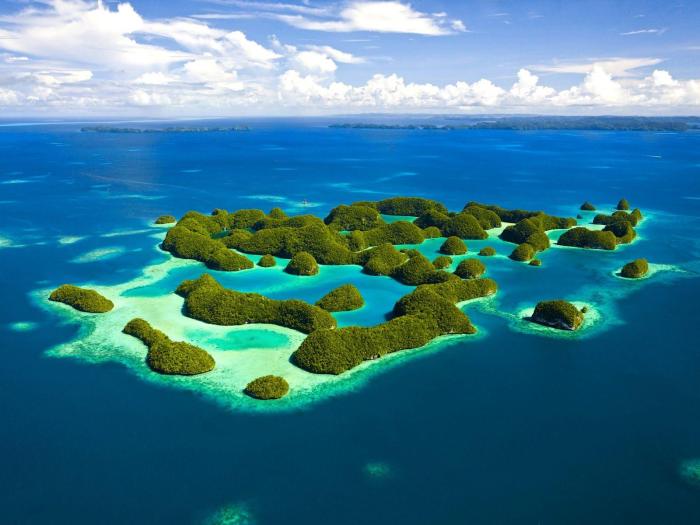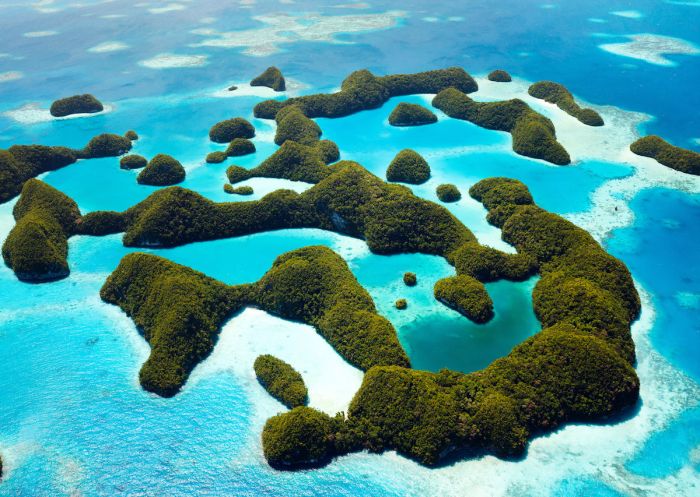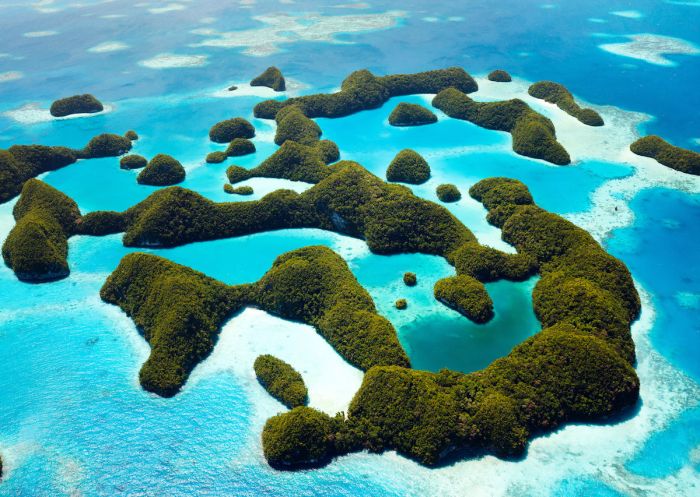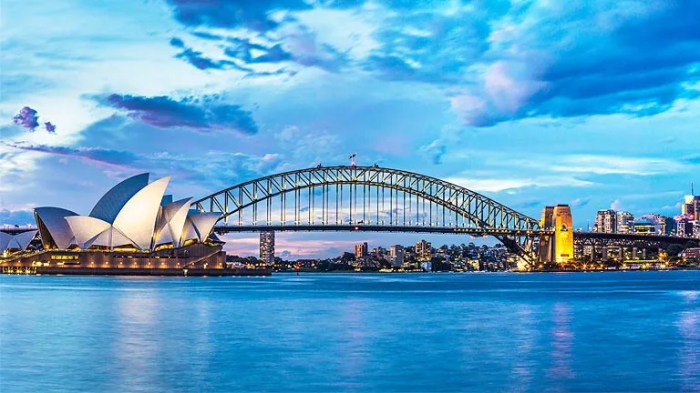Palau bans sunscreen coral, a bold move to protect its delicate ecosystem. This ban, rooted in a deep commitment to environmental preservation, highlights the crucial link between human activity and the health of coral reefs. The decision underscores the urgency of finding sustainable solutions for sun protection while safeguarding these vital marine environments. The ban, while potentially impacting tourism, demonstrates Palau’s prioritization of long-term ecological health over short-term economic gains.
This comprehensive look at Palau’s sunscreen ban explores the scientific reasons behind the decision, examines the potential impacts on coral reefs and the local economy, and considers alternative sunscreens. It also delves into public awareness campaigns and international cooperation efforts aimed at preserving these vital ecosystems.
Palau’s Sunscreen Ban
Palau, a stunning island nation in Micronesia, has recently taken a bold step to protect its delicate coral reefs. The ban on sunscreens containing oxybenzone and octinoxate highlights a growing global concern about the impact of chemical pollutants on marine ecosystems. This ban underscores Palau’s long-standing commitment to environmental stewardship and its proactive approach to safeguarding its natural heritage.
Palau’s Environmental Protection History
Palau has a rich history of prioritizing environmental protection. For decades, the nation has recognized the importance of its unique marine biodiversity and has actively worked to establish marine protected areas. This commitment extends beyond the recent sunscreen ban, reflecting a sustained effort to safeguard its coral reefs and other ecosystems from human-induced harm. The nation has consistently championed sustainable practices, emphasizing responsible tourism and fisheries management.
Reasons Behind the Sunscreen Ban
The ban on oxybenzone and octinoxate stems from scientific evidence demonstrating their harmful effects on coral reefs. These chemicals, commonly found in many sunscreens, have been shown to disrupt coral reproduction and growth. Studies have shown that exposure to these chemicals can lead to coral bleaching, making them more vulnerable to disease and stress. This impacts the entire ecosystem, harming fish populations, and other marine life that depend on coral reefs for survival.
Scientific Evidence Supporting the Ban
Extensive research from various scientific institutions has corroborated the detrimental effects of oxybenzone and octinoxate on coral reefs. Numerous studies have examined the impact of these chemicals on coral larvae and adult corals, revealing a clear correlation between exposure and adverse outcomes. The scientific community has overwhelmingly supported the need for regulation or restrictions on these chemicals in sunscreens, particularly in sensitive marine environments.
Palau’s recent ban on sunscreen containing oxybenzone and octinoxate is a big deal for coral reefs. It’s a stark reminder of how our everyday choices can impact fragile ecosystems. Fortunately, there are plenty of ways to still enjoy the outdoors responsibly, like checking out the best camping spots in Europe for furry friends. Camping in Europe with dogs is a fantastic option if you’re looking for a fun, pet-friendly adventure.
Hopefully, Palau’s example will inspire other destinations to take similar steps to protect their marine life.
Examples include published research papers from reputable institutions, demonstrating the negative impact of these chemicals on coral growth, reproduction, and health.
Comparison to Similar Regulations
While Palau’s ban is a notable action, similar concerns and regulations are emerging in other parts of the world. Several countries and regions have either implemented or are considering restrictions on the use of oxybenzone and octinoxate in sunscreens. This demonstrates a growing global recognition of the need for stricter environmental regulations regarding chemical pollutants in personal care products.
This reflects a global trend towards adopting more sustainable practices.
Potential Economic Impacts of the Ban
The ban on sunscreens containing oxybenzone and octinoxate may impact Palau’s tourism sector. However, this potential negative economic impact is being weighed against the long-term benefits of preserving the coral reefs. Palau’s tourism industry relies heavily on its pristine environment, and the protection of its reefs is crucial for its long-term sustainability. The economic benefits of preserving the ecosystem may outweigh short-term economic losses from decreased sales of sunscreens containing these chemicals.
Table: Palau’s Sunscreen Ban
| Location | Reason for Ban | Date of Ban | Key Substances Banned | Supporting Scientific Evidence |
|---|---|---|---|---|
| Palau | Harmful effects on coral reefs, including disruption of reproduction, growth, and increased vulnerability to disease and stress. | [Date of Ban] | Oxybenzone, Octinoxate | Numerous studies demonstrating the negative impact of these chemicals on coral health, growth, and reproduction. References to specific published research papers, if available. |
Impact on Coral Reefs: Effects of Sunscreen Chemicals
Coral reefs, vibrant underwater ecosystems, are facing a significant threat from the chemicals in some sunscreens. These seemingly innocuous products are causing considerable harm to these delicate marine environments. The impact is substantial, affecting coral health, reproduction, and ultimately the entire reef ecosystem.Sunscreen chemicals like oxybenzone and octinoxate, commonly found in many popular sunscreens, are particularly harmful to coral reefs.
These chemicals, when entering the water, can have detrimental effects on the delicate structures and life processes of these marine organisms. The long-term consequences of this damage are far-reaching and could jeopardize the very existence of these vital marine habitats. Understanding these impacts is crucial for promoting responsible sun protection strategies that minimize harm to the environment.
Harmful Effects of Oxybenzone and Octinoxate
Oxybenzone and octinoxate, while effective at absorbing ultraviolet radiation, are known to disrupt coral health and reproduction. These chemicals can cause coral bleaching, a process where corals expel the symbiotic algae that provide them with color and nourishment. This loss of algae leaves the corals vulnerable to disease and death. Further, these chemicals can interfere with coral reproduction, impacting the development of coral larvae and the overall health of the reef.
Palau’s recent ban on sunscreen containing oxybenzone and octinoxate is a big deal for coral reefs. It’s a serious step to protect these incredible ecosystems, but it also means travelers need to be mindful of their packing choices. Checking out travel tips on packing light and comfy shoes, like the ones from travel tips packing tips samantha brown shoe walking travel , is crucial for comfortable adventures while respecting the environment.
After all, we want to keep Palau’s pristine beauty intact for future generations to enjoy.
Coral Reef Damage Mechanisms
Coral reefs are affected in several ways by sunscreen exposure. The chemicals can directly harm the coral tissue, leading to lesions and tissue death. Furthermore, they can disrupt the delicate symbiotic relationship between corals and their associated algae, leading to bleaching events. Additionally, these chemicals can negatively impact the reproductive cycle of corals, affecting the survival of coral larvae.
The cumulative effect of these stressors can lead to significant long-term damage to the reef ecosystem.
Long-Term Consequences of Reef Damage
The damage to coral reefs caused by sunscreen chemicals has significant long-term consequences. Coral reefs provide essential habitats for a wide range of marine species, supporting biodiversity and fisheries. Their degradation leads to a loss of these crucial habitats and can have cascading effects throughout the marine ecosystem. The loss of coral reefs also negatively impacts coastal communities that rely on them for tourism, fishing, and protection from storms.
Potential Consequences of the Ban on Tourism and Related Industries
A ban on sunscreen use, while necessary to protect coral reefs, could potentially impact tourism and related industries. Many tourists visit Palau and other tropical destinations to enjoy the beauty of coral reefs. A decrease in tourism revenue could affect local economies. However, the long-term benefits of coral reef preservation often outweigh short-term economic concerns. Alternative tourism strategies that emphasize sustainable practices and environmental responsibility can help mitigate these economic impacts.
Mitigation Strategies
| Sunscreen Chemical | Effect on Coral | Mechanism of Damage | Potential Mitigation Strategies |
|---|---|---|---|
| Oxybenzone | Coral bleaching, tissue damage | Disrupts symbiotic algae relationship, directly harms coral tissue | Use of mineral-based sunscreens (zinc oxide, titanium dioxide), development of sunscreen alternatives, education campaigns |
| Octinoxate | Coral bleaching, reproductive disruption | Disrupts symbiotic algae relationship, affects coral larvae development | Use of mineral-based sunscreens (zinc oxide, titanium dioxide), development of sunscreen alternatives, education campaigns |
Alternatives to Harmful Sunscreen Chemicals
Protecting our precious coral reefs demands a shift away from harmful sunscreen chemicals. This shift necessitates exploring and understanding viable alternatives. The transition requires careful consideration of efficacy, safety, and environmental impact. Consumers and policymakers must collaborate to implement sustainable practices that safeguard these delicate ecosystems.Reef-safe sunscreens are specifically formulated to minimize harm to coral reefs and marine life.
They use ingredients that are less damaging to coral and marine ecosystems. These formulations prioritize natural, environmentally friendly alternatives to traditional chemical sunscreens.
Palau’s recent ban on sunscreen containing harmful chemicals impacting coral reefs is a serious issue. While exploring stunning destinations like Darby Montana, a beautiful area perfect for a nature-focused trip, it’s important to remember the environmental impact of our choices. Checking out a darby montana travel guide can highlight eco-friendly travel tips. This Palau initiative shows how crucial it is to consider our impact when enjoying stunning natural environments.
Types of Reef-Safe Sunscreen
Many reef-safe sunscreens utilize mineral-based filters, such as zinc oxide and titanium dioxide. These minerals create a physical barrier on the skin, reflecting sunlight rather than absorbing it. This method avoids the potential harm associated with chemical absorption into the skin and subsequent release into the environment. Other formulations utilize natural oils and extracts, often derived from plants.
These natural ingredients are typically considered less harmful to coral reefs and marine life.
Active Ingredients in Reef-Safe Sunscreens
A variety of natural and mineral-based ingredients serve as active filters in reef-safe sunscreens. Zinc oxide and titanium dioxide are common mineral-based ingredients. They work by creating a physical barrier on the skin, deflecting ultraviolet radiation. Natural oils and extracts, such as those derived from plants or algae, can also act as effective filters.
Chemical Properties and Safety Profiles of Reef-Safe Alternatives
Mineral-based filters, like zinc oxide and titanium dioxide, have a high safety profile. Their chemical properties result in a physical barrier that blocks UV radiation. They do not absorb into the skin, significantly reducing the risk of environmental contamination. Natural ingredients often derived from plants or algae are also considered relatively safe. They have a lower potential for environmental harm.
However, thorough testing and research remain essential to ensure their safety.
Comparison of Sunscreen Types
| Sunscreen Type | Active Ingredients | Reef Safety Rating | Availability |
|---|---|---|---|
| Mineral-Based | Zinc Oxide, Titanium Dioxide | High | Widely available in various formulations |
| Plant-Based | Natural oils and extracts (e.g., avocado oil, aloe vera) | Medium to High | Increasingly available, often in specialized stores or online |
| Chemical | Oxybenzone, Octinoxate | Low | Common in many over-the-counter sunscreens |
This table summarizes the key characteristics of different sunscreen types, highlighting their active ingredients, reef safety ratings, and availability. It demonstrates the range of options now available to consumers. The availability of mineral-based and plant-derived sunscreens is growing, making sustainable choices more accessible.
Availability of Reef-Safe Sunscreens
Reef-safe sunscreens are becoming increasingly accessible. Retailers and online marketplaces are expanding their selections of these products. Consumers can readily find a wider range of options in various formulations. This growing availability makes the transition to reef-safe sunscreen choices easier for consumers.
Public Awareness and Education Initiatives: Palau Bans Sunscreen Coral

Protecting Palau’s precious coral reefs requires a multifaceted approach, and public awareness campaigns play a crucial role in fostering responsible behavior. Educating the public about the impact of sunscreen chemicals on coral reefs and providing viable alternatives is essential for achieving long-term sustainability. This involves clearly communicating the science behind the issue and empowering individuals to make informed choices.Palau’s commitment to reef conservation extends beyond policy implementation to encompass comprehensive educational initiatives.
These programs aim to shift public perception and promote environmentally conscious practices regarding sunscreen use. Understanding the diverse methods used by Palau to educate its citizens and the effectiveness of these approaches provides valuable insights into successful conservation strategies.
Education Methods and Target Audiences
Palau employs a variety of strategies to communicate the importance of reef-safe sunscreen to its diverse population. These initiatives are designed to be accessible and engaging, catering to various age groups and cultural backgrounds. A comprehensive strategy considers different learning styles and ensures information reaches all segments of society.
| Education Method | Target Audience | Description |
|---|---|---|
| Public Service Announcements (PSAs) | General Public | Short, impactful video or audio messages broadcast on local media outlets. These PSAs often highlight the harmful effects of conventional sunscreens on coral reefs and showcase alternatives. |
| Community Workshops and Seminars | Local residents, tourists, and businesses | Interactive sessions conducted by environmental experts, providing practical information on reef-safe sunscreen options and their use. These events often include demonstrations and Q&A sessions. |
| School Programs | Children and adolescents | Educational materials and presentations tailored for the educational curriculum. These programs aim to integrate environmental awareness into the younger generation’s learning. |
| Social Media Campaigns | Youth and digital-savvy individuals | Engaging posts, infographics, and videos shared on social media platforms to raise awareness and disseminate information. These campaigns often use creative visuals and interactive elements to enhance engagement. |
| Tourism Industry Partnerships | Tourists and hotel staff | Collaboration with tourism businesses to educate tourists about the sunscreen ban and promote the use of reef-safe products. Hotels might include information on reef-safe sunscreens in their amenities. |
Examples of Public Awareness Materials
Palau’s commitment to public awareness is evident in the variety of materials developed. These materials are designed to reach diverse audiences and effectively communicate the importance of reef-safe sunscreen choices.
- Brochures and Flyers: Informative materials outlining the benefits of reef-safe sunscreens and providing a list of recommended products. These materials are distributed at tourist sites, markets, and community centers.
- Posters and Signage: Visually appealing displays highlighting the impact of sunscreen chemicals on coral reefs. These posters are often placed in prominent locations like beaches, tourist centers, and public transportation.
- Website and Online Resources: A dedicated website with detailed information about the sunscreen ban, its rationale, and readily available reef-safe options. Online resources often include interactive maps, Q&A sections, and links to relevant scientific research.
International Cooperation and Policy Implications
Palau’s bold move to ban harmful sunscreen chemicals highlights the urgent need for international collaboration in protecting our shared marine ecosystems. The ripple effects of this decision extend far beyond Palau’s shores, demanding a global conversation about responsible chemical use and the long-term health of coral reefs. This necessitates a proactive approach, not only from individual nations but also from international organizations.Protecting coral reefs is a global imperative, as they provide critical ecosystem services, including coastal protection, biodiversity hotspots, and support for fisheries.
The decline in coral reef health worldwide underscores the necessity for coordinated efforts to address this global environmental challenge. This includes not only understanding the impacts of chemicals like oxybenzone and octinoxate, but also exploring innovative solutions and sustainable alternatives.
Potential for International Cooperation, Palau bans sunscreen coral
International cooperation is crucial for effectively addressing the multifaceted challenges faced by coral reefs. Collaborative research projects, data sharing, and the development of standardized testing protocols are essential for advancing our understanding of reef health and the impacts of sunscreen chemicals. This necessitates a shared commitment to research and development, including the identification and testing of safe alternatives.
Best Practices for Protecting Coral Reefs Globally
Establishing clear international standards and regulations regarding sunscreen chemicals is paramount. Sharing best practices among nations regarding sunscreen regulation and promoting sustainable alternatives is critical. Effective communication and education initiatives, both within and across countries, can promote awareness and encourage responsible consumer choices. The establishment of protected areas and the implementation of sustainable fishing practices are further crucial components of global coral reef protection.
Implications of Palau’s Ban for Other Nations
Palau’s ban serves as a catalyst for broader discussions and potential actions in other nations facing similar environmental concerns. This could lead to similar regulatory measures in other regions, driving the development of safer and more sustainable alternatives to harmful sunscreen chemicals. The experience of Palau could offer valuable lessons and inspiration for other countries to implement stricter regulations.
International Organizations and Initiatives Related to Coral Reef Protection
Several international organizations play a pivotal role in coral reef conservation. These include the Global Coral Reef Monitoring Network (GCRMN), the International Coral Reef Initiative (ICRI), and the United Nations Environment Programme (UNEP). These organizations collaborate with governments and researchers to implement projects aimed at preserving and restoring coral reefs globally.
Comparison of International Approaches to Sunscreen Regulation
International approaches to sunscreen regulation vary significantly. Some nations have already implemented regulations limiting the use of specific chemicals, while others are still in the early stages of considering such policies. This disparity highlights the need for greater harmonization of regulations across countries to ensure effective protection of coral reefs.
Table: Countries with Similar Bans and Specific Regulations
| Country | Banned Chemicals | Specific Regulations |
|---|---|---|
| Palau | Oxybenzone, Octinoxate | Complete ban on sunscreen products containing these chemicals |
| (Example 2) | (Chemical List) | (Specific Regulations) |
| (Example 3) | (Chemical List) | (Specific Regulations) |
Note: This table is a placeholder and requires filling in with actual data from relevant sources. Examples 2 and 3 represent hypothetical cases to illustrate the format.
Economic and Social Impacts of the Ban

Palau’s ambitious ban on sunscreen containing harmful chemicals poses significant challenges, particularly for its vital tourism industry. This ban, while environmentally crucial, necessitates careful consideration of the economic and social repercussions it might induce. The potential impact on Palauan livelihoods, cultural practices, and long-term economic stability requires careful analysis and proactive strategies.The ban on harmful sunscreen chemicals is a bold move, aiming to protect Palau’s pristine coral reefs.
However, this measure may unintentionally disrupt the tourism sector, a major source of income for the country. The interconnectedness of the economy and environment highlights the need for balanced solutions. Tourism is deeply entwined with Palau’s culture and identity, and any significant disruption could have cascading effects.
Economic Consequences for Palauan Businesses
The tourism sector in Palau is heavily reliant on attracting visitors. Many businesses, from resorts and dive operators to local shops and restaurants, are directly or indirectly tied to the flow of tourists. A decrease in tourism, potentially stemming from concerns about the availability of compliant sunscreen, could lead to reduced revenue, job losses, and a contraction of the local economy.
The ban, while environmentally beneficial, necessitates a careful strategy to mitigate these negative economic consequences.
Job Losses and Changes in Employment Opportunities
The Palauan economy is heavily dependent on tourism, and job losses within the sector would significantly impact individuals and families. Potential job losses could affect hotel staff, tour guides, dive instructors, and other workers in the hospitality industry. Shifting employment opportunities towards alternative industries, such as sustainable eco-tourism and eco-friendly product manufacturing, are crucial for mitigating these effects.
This transition may require training and development programs to equip Palauan workers with the necessary skills for new roles.
Social Impacts on Palauan Communities
The ban on sunscreen impacts traditional Palauan water-based activities. Cultural and traditional practices often involve extensive time spent in the ocean. The ban may inadvertently restrict these activities if compliant sunscreen alternatives are unavailable or prohibitively expensive. Addressing these concerns through community outreach and education programs is essential to ensure the ban does not impede traditional practices.
Long-Term Effects on Palau’s Economy
The long-term consequences of the ban could range from a significant reduction in tourism revenue to a complete restructuring of the economy. The loss of tourism revenue could have ripple effects throughout the economy, impacting related industries and potentially leading to a decline in government revenue. Developing alternative revenue streams, such as promoting sustainable eco-tourism, eco-friendly product manufacturing, and promoting unique cultural experiences, is essential for Palau’s economic resilience in the long run.
Economic Adjustments and Alternative Revenue Streams
Developing new revenue streams that align with the ban is crucial for Palau’s long-term economic sustainability. One example is promoting eco-tourism and sustainable activities. By focusing on unique cultural experiences, such as traditional ceremonies and showcasing local artistry, Palau can attract tourists interested in responsible travel. This strategy requires proactive marketing and the development of infrastructure to support these new activities.
Partnerships with international organizations or businesses with experience in sustainable tourism could facilitate this transition. For example, promoting sustainable fishing practices and showcasing Palau’s unique marine ecosystem through documentaries or online platforms can attract eco-conscious tourists.
Future Research and Monitoring Efforts
The Palau sunscreen ban presents a unique opportunity to understand the long-term effects of sunscreen chemicals on coral reefs. Continued research and robust monitoring programs are crucial to evaluate the effectiveness of the ban and inform future policies aimed at protecting marine ecosystems. The data gathered will not only benefit Palau but can also serve as a valuable case study for other nations facing similar environmental challenges.
The Necessity of Continued Research on Coral Reef Health
Coral reefs are complex and dynamic ecosystems. To understand the full impact of the sunscreen ban, comprehensive research is needed to evaluate the health of Palau’s coral reefs over time. This includes studying the abundance, diversity, and resilience of coral species. Changes in coral growth rates, bleaching events, and disease prevalence need to be monitored. Long-term studies are essential to detect subtle changes that might not be apparent in short-term observations.
The baseline data gathered before the ban implementation is critical for comparison with future data to assess the impact of the ban.
The Role of Monitoring Programs in Assessing the Impact of the Ban
Monitoring programs play a vital role in evaluating the effectiveness of the Palau sunscreen ban. These programs should employ standardized methods for data collection, ensuring consistency and comparability over time. Regular surveys and assessments of coral reef health are essential, encompassing both quantitative and qualitative data. Visual assessments of coral health, along with quantitative measurements of coral cover, species diversity, and associated marine life, should be part of the monitoring protocols.
Using advanced technologies like underwater video surveys and coral growth analysis can enhance the accuracy and efficiency of the monitoring process.
Importance of Data Collection and Analysis
Thorough data collection and meticulous analysis are essential to draw meaningful conclusions about the impact of the ban. Data should be collected using standardized protocols to ensure reliability and comparability across different time periods and locations. Statistical analysis can help identify patterns and trends in coral health, allowing researchers to determine if the ban is having the desired effect.
This includes examining the relationship between sunscreen chemical concentrations in the water and coral health indicators. The data should be presented in accessible formats, such as reports and interactive maps, to facilitate communication and public awareness.
Specific Research Areas to Investigate
- Assessing the concentration of sunscreen chemicals in Palau’s waters: This research should focus on determining the levels of different sunscreen chemicals (like oxybenzone and octinoxate) in various locations and depths of the reef environment. The data collected will be used to identify the effectiveness of the ban on reducing chemical concentrations.
- Investigating the impact of sunscreen chemicals on coral growth and reproduction: This research will focus on how exposure to different sunscreen chemicals affects coral larvae development, growth rates, and reproduction rates. Controlled laboratory experiments and field observations are critical in this area.
- Evaluating the relationship between sunscreen chemical exposure and coral diseases: This study will determine whether specific sunscreen chemicals contribute to or exacerbate coral diseases. Correlational analyses and laboratory studies will be key methods.
- Exploring the effects of sunscreen chemicals on other marine organisms: This research will investigate how sunscreen chemicals impact other marine species, including fish, invertebrates, and algae. This will help provide a broader understanding of the ecological consequences of the ban.
- Developing alternative sunscreen formulations: Research should focus on the development and testing of environmentally friendly sunscreen alternatives that do not harm coral reefs. This research is crucial to ensure that individuals can still protect themselves from the sun while preserving marine ecosystems.
Potential Research Areas
| Research Area | Methods | Expected Outcomes | Timeline |
|---|---|---|---|
| Sunscreen chemical concentration in Palau waters | Water sampling at various locations, chemical analysis | Quantitative data on sunscreen chemical concentrations; identification of trends over time | 1-3 years |
| Impact of sunscreen chemicals on coral growth | Controlled laboratory experiments, field observations | Data on the effects of sunscreen chemicals on coral growth rates, morphology, and reproductive success | 2-5 years |
| Relationship between sunscreen chemicals and coral diseases | Monitoring coral health, correlational analysis, laboratory studies | Evidence linking sunscreen chemical exposure to coral diseases; identification of susceptible species | 3-7 years |
| Effects of sunscreen chemicals on other marine organisms | Field observations, laboratory experiments | Data on the impacts of sunscreen chemicals on fish, invertebrates, and algae | 2-5 years |
| Development of environmentally friendly sunscreens | Formulation development, laboratory testing, field trials | Development and testing of effective and environmentally friendly sunscreen alternatives | 3-7 years |
Ending Remarks
Palau’s bold stance on banning sunscreen containing harmful chemicals like oxybenzone and octinoxate serves as a powerful example of environmental stewardship. While the economic implications are significant, the potential for long-term damage to coral reefs, and the subsequent loss of biodiversity, underscores the need for such decisive action. The future of coral reefs globally depends on a combination of local action, international cooperation, and the development of sustainable alternatives.
This ban compels us to re-evaluate our personal and collective responsibilities in protecting these fragile ecosystems.







